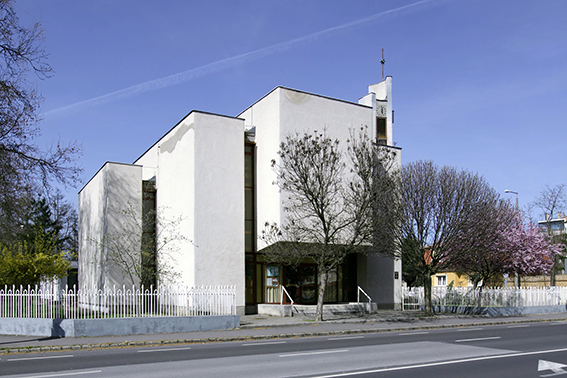La continuidad del espacio protestante
Coherencias litúrgico-arquitectónico-estructurales de la arquitectura religiosa protestante húngara del siglo XX
DOI:
https://doi.org/10.17979/aarc.2017.5.0.5146Palabras clave:
arquitectura religiosa, tipología protestante, arquitectura moderna, planta central, HungríaResumen
En las últimas décadas se han comenzado a hacer intensos esfuerzos para conocer la arquitectura religiosa de la Europa central y oriental, y más en concreto, húngara. En un período históricamente depresivo como 1920/1945/1989, los edificios eclesiales fueron hitos importantes para la creación de una identidad en la vida de las comunidades protestantes, renacidas tras el reordenamiento de las fronteras del país. Los principios arquitectónicos modernos y las cuestiones estructurales y litúrgicas posibilitaron continuas experimentaciones en el período examinado, que generaron una tendencia centralizadora entre las dos guerras mundiales.
Analizando la organización del espacio protestante, se puede comprobar cómo estas tendencias centralizadoras con carácter identitario se mantuvieron en la arquitectura eclesial a pesar de los acontecimientos histórico-políticos de la Segunda Guerra Mundial. La importancia primordial del estudio es el examen holístico de la arquitectura eclesial protestante del siglo XX. El estudio muestra la actividad de las Iglesias protestantes del período a través de las dos denominaciones más significativas —la calvinista y la luterana—, proporcionando así un enfoque tipológico.
Descargas
Métricas
Citas
Baku, Eszter. 2013. «Tradition and Liturgy. Centralising Tendencies of Lutheran Church Architecture in Hungary during the Interwar Period». Periodica Polytechnica Architecture 44/1:1-8.
Baku, Eszter. 2016. «Theory and Practice: Protestant church architecture beween the two world wars». Architectura Hungariae 15/3:133-146.
Bibó, István. 1985. «Der protestantische Kirchenbau in Ungarn um 1800». Mitteilungen der Gesellschaft für Vergleichende Kunstforschung in Wien 37/3:1-5.
Foltin, Brunó. 1992. «Az evangélikus templom». In Evangélikus templomok Magyarországon, edited by Dercsényi, Balázs and Brunó Foltin, Katalin G. Gyõrffy, Gábor Hegyi, Gábor Winkler, Zsuzsanna Zászkaliczky, 11-22. Budapest: Hegyi&Tsa.
Friedrich, Lóránd. 1944. «A Magyar evangélikus templom fejlõdése az újkorban». In Evangélikus templomok, edited by Lajos Kemény and Károly Gyimesi, 169-192. Budapest: Athenaeum.
Krähling, János, and Gergely Domonkos Nagy. 2009. «Late baroque greek-cross plan type Lutheran churches in Hungary». Periodica Polytechnica Architecture 40/2. 77-86.
Krähling, János. 2008. «A 20. századi magyarországi evangélikus templomépítészet a rendszerváltozásig». In Új evangélikus templomok, edited by János Krähling and Zorán Vukoszávlyev, 21-28. Budapest: Luther Kiadó.
Krähling, János. 2008b. «Gyülekezeti központok a XX. század szakrális építészetében». Építés-Építészettudomány 36/1-2:119-127.
Krähling, János. 2015. «The protestant church architecture of East-Central Europe in the seventeenth and eightteenth centuries: From medieval heritage to new spatial solutions». In Protestantischer Kirchenbau der Frühen Neuzeit in Europa – Grundlagen und neue Forschungskonzepte, edited by Jan Harasimowicz, 131-146. Regensburg: Schnell und Steiner.
Lõrincz, Zoltán. 2000. Ne hagyjátok a templomot: Új református templomok 1990-1999. Budapest: Kálvin Kiadó.
Medgyaszay, István. 1942. «Templomstílusok». In Református templomok Magyarországon, edited by János I. Kováts, 15-68. Budapest: Athenaeum.
Pecz, Samu. 1888. «A protestáns templomok építésérõl, kapcsolatban a debreceni kálvinista új templom részletes ismertetésével». A Magyar Mérnök- és Építész Egylet Közlönye 22:193-205, 241-251.
Ravasz, László. 1942. «A református templom». In Református templomok Magyarországon, edited by János I. Kováts, 1-4. Budapest: Athenaeum.
Mentzer Jr., Raymond A. 1999. «The Reformed Churches of France and the Visual Arts». In Seeing Beyond the Word: Visual Arts and the Calvinist Tradition, edited by Paul Corby Finney, 199-230. Cambridge: William B. Eerdmans Publishing.
Róka, Enikõ. 1996. «Pecz Samu Szilágyi Dezsõ téri református temploma és a protestáns centralizáló templomépítészeti hagyomány». Ars Hungarica 24/2:117-175.
Róka, Enikõ. 2008. «Centralizáló törekvések a protestáns templomépítészetben, Európa és Magyarország, 16-19 század». Régi-Új Magyar Építõmûvészet Utóirat 46:11-18.
Schnell, Hugo. 1974. Twentieth Century Church Architecture in Germany: Documentation, Presentation, Interpretation. Munich/Zurich: Schnell & Steiner.
Schulek, János. 1942. «Kísérletek új református templomstílus megteremtésére». In Magyar református templomok, edited by István J. Kováts, 339-349. Budapest: Athenaeum.
Sturm, Leonhard Christoph. 1712. Architektonisches Bedencken von Protestantischer Kleinen Kirchen Figur und Einrichtung. Hamburg: Schiller.
Sturm, Leonhard Christoph. 1718. Vollständige Anweisung alle Arten von Kirchenwohl anzugeben. Augsburg: Wolff.
Vukoszávlyev, Zorán. 2012. «Unifying the Community: The Evolution of Centralized Space in Hungarian Church Architecture 1900-2010». In Proceedings of the 2nd International Conference of the European Architectural History Network, edited by Hilde Heynen and Janina Gosseye, 364-365. Brussels: Koninklijke Vlaamse Academie van Belgie voor Wetenschappen en Kunsten.
Vukoszávlyev, Zorán, and Erzsébet Urbán. 2016. «Magyarország templomépítészete 1945–1964 között: Vázlat az alkotómûvészi értékeléssel megállapítható építészeti folytonosságról». Építés- Építészettudomány 44/1-2:247-315.
Vukoszávlyev, Zorán. 2016. «A 20. század hazai református templomépítészetének tendenciái: Egy tipológiai rendszer alapvetései». Architectura Hungariae 15/3:157-170.
















